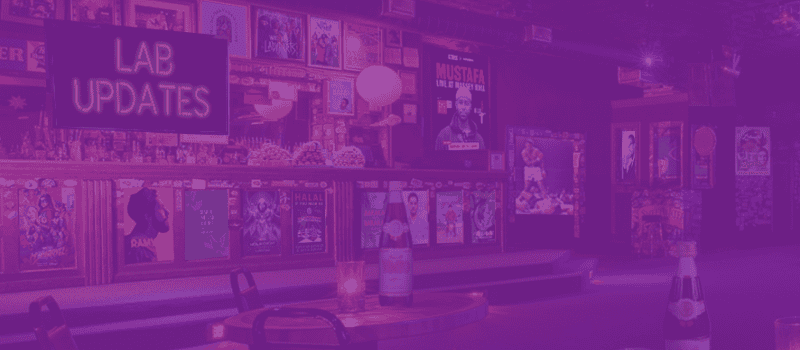
Swimming in the Narrative Ocean | Lab Update
Developing the Narrative Change Lab has not been an easy process. The ideas and timelines we began with have been set aside for something unlike what we imagined.
The Lab has expanded and is now made up of three parts collectively focused on (1) creating and developing (new) narratives, (2) investing in research and (3) studying audiences.
We have been challenged to dig deep and ask hard questions about how narratives develop, particularly the negative ones. How have various actors and platforms actively contributed over the centuries to the expansion of a system that, much like a spider’s web, produces and reproduces the same rotting stories that transform singular narratives into mainstream beliefs? And how do we forge a completely new path, one that is unconcerned with changing what exists but rather focused on looking forward to what is and can be? The process has also made us consider what our role is as a funder and where we can best support the development of something new in Canadian philanthropy, but with great potential benefits for the communities we serve.
For Muslims, as with many other communities, narrative work, particularly narrative change, isn’t simply about spreading a bunch of positive stories spotlighting their contributions and ‘humanizing’ them. Although the heart-warming stories are nice, maybe even great soundbites, they are not enough, nor do they make change. The fact is we need to look beyond the small pieces and moments of representation, and consider what change looks like. The kind of change that cuts deep and transforms people’s behaviours, desperately needed now, forces us to look at the entire narrative ocean. That is, the ecosystems of narratives, ideas, and cultural norms that shape the behaviors, mindsets, and worldviews of mass audiences [1].
As Bridgit Antoinette Evans explains: [vc_row][vc_column][mk_blockquote font_family=”none”]“The hard truth is that large swaths of the narrative “ocean” in which we currently swim are toxic—poisoned with terrible ideas about who we are, who belongs, and who does not. On the best of days, these ideas make it hard to see through the muck. They distort our sense of self and our faith in our ability to meet each other across our differences. At worst, the ideas swirling in these narrative waters are killing some of us, and our planet.” [2] [/mk_blockquote][vc_column_text]For our work, we recognize that great narratives without a system (i.e., the ‘ocean’) to support them, give them life, and link them to mass audiences, will only remain a collection of pleasant stories.
The Lab is our first step in this direction. But, to create new narratives and have them connect with audiences in a way that makes them question their actions, believe that a different reality is possible [3], and demand that things be different, starts by laying foundations. We need to answer three important questions: 1) what are the new Muslim narratives we want to support promote, support and embed in the public imagination? 2) what does the current Muslim landscape look like in Canada? and 3) who are the audiences and how do we connect with them?
As we continue to build out the Lab and develop a narrative change process that centres Muslims, we confront two critical issues. First, we move on a narrative change path that does not focus on the existing narratives, choosing instead to look forward to what Muslims can be from where they stand. However, in a field where most of the thought and movement on narratives comes from secular spaces, we explore what narrative change can look like coming from a religious community. Specifically, how do we develop a narrative change model at the intersections of Muslim, Islam, arts and media?
Second, we dive into the intricacies of power, certain that dominant worldviews supported in the public space are possible because of power relationships [4]. Narrative power, defined as “the ability to create leverage over those who set the incentives, rules and norms that shape society and human behavior…[and] having the power to defeat the establishment of belief systems that oppose us” [5], is a non-negotiable factor in narrative change. The key question then becomes: how can a narrative change model factor in power in a way that results in narrative building power for people? [6][/vc_column_text][/vc_column][/vc_row][vc_row][vc_column][mk_divider style=”thick_solid”][vc_column_text]Written by Angie Balata | October 19, 2021 [/vc_column_text][/vc_column][/vc_row][vc_row][vc_column][mk_divider style=”thick_solid”][vc_column_text]Footnotes:
[1] From Stories to Systems: Using Narrative Systems Approach to Inform Pop Culture Narrative Change Grantmaking, Bridgit Antoinette Evans, p. 3
[2] Pop Culture Collab, From Stories to Systems: Using Narrative Systems Approach to Inform Pop Culture Narrative Change Grantmaking, Bridgit Antoinette Evans, p. 2
[3] Pop Culture Collab, From Stories to Systems: Using Narrative Systems Approach to Inform Pop Culture Narrative Change Grantmaking, p.4
[4] The role of narrative change in influencing policy, Brett Davidson
[5] Rashad Robinson, Changing Our Narrative About Narrative: The Infrastructure Required for Building Narrative Power
[6] Rashad Robinson, Changing Our Narrative About Narrative: The Infrastructure Required for Building Narrative Powe
[/vc_column_text][/vc_column][/vc_row]